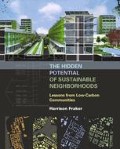Abstract
Hammarby Sjöstad, “the town around the lake,” is the largest mixed-use housing development undertaken by the city of Stockholm since the 1960s. It is also one of the most financially successful in the city as well as a recognized model of sustainable neighborhood development around the world. The site, which is reclaimed industrial land, is located in a valley with little wind power potential and has only a modest amount of winter solar radiation for Stockholm’s cold climate. With such poor sources of renewable energy, how has the neighborhood become such a model of sustainable development? The secret lies in the waste flows and the city’s integrated approach to the design of its infrastructure.
Rights and permissions
Copyright information
© 2013 Harrison Fraker
About this chapter
Cite this chapter
Fraker, H. (2013). Hammarby Sjöstad, Stockholm, Sweden. In: The Hidden Potential of Sustainable Neighborhoods. Island Press, Washington, DC. https://doi.org/10.5822/978-1-61091-409-3_3
Download citation
DOI: https://doi.org/10.5822/978-1-61091-409-3_3
Publisher Name: Island Press, Washington, DC
Print ISBN: 978-1-59726-368-9
Online ISBN: 978-1-61091-409-3
eBook Packages: Earth and Environmental ScienceEarth and Environmental Science (R0)

